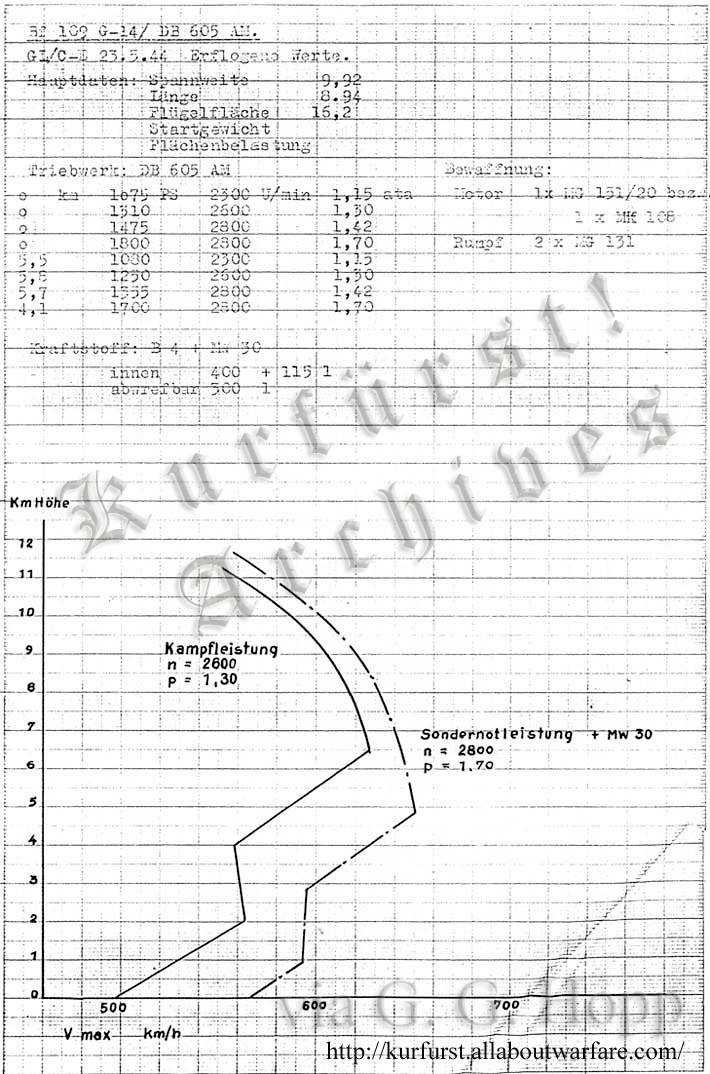
|
The below
set of level speed
performance appears to be obtained through flight trials (erflogene Werte or 'flight tested
figures') for the Bf 109G-14 with the DB 605AM engine, at 1.7ata boost
and 2800 rpm together with MW-30 injection, designated Sondernotleistung. Note that the
trials were performed with MW-30 (Methanol-Wasser
30), which had slightly different composition than MW-50. Te
former contained apprx. 30% of methanol, the latter 50% methanol, with
the rest being distilled water, with 1% being standard engine lubricant
oil. MW-50 was the standard boosting agent in service. Although MW-50
could be substituted with MW-30, MW-30 would yield slightly different
engine outputs.
Sondernotleistung was allowed for a maximum of 10 minutes of continous use. Figures and details for the 30-min Steig- und Kampfleistung are also given. As can be noted, the use of MW-50 boost improved engine output greatly under the engine's critical alt. Initially the booster system was retrofitted to G-5s and G-6s, and starting with the G-14 and all later Bf 109 models until the end of the war, the MW-50 booster become a standard factory fitting. The figures are also appliable to those Bf 109G-6s (and G-5s) that were modified with MW-50 boost in early 1944, as the difference between the aircraft were marginal. This very simple modification primarly effected the G-6/U2 subtypes, which were already equipped with the extra tank and plumbing, originally for GM-1 boost. Examples of such boosted planes are known in service April 1944 the earliest, and it's known that in May 1944 an order for 250 conversion kits were ordered, before the G-14 standard was accepted, giving an idea of the scale of use. The G-14, noted in German type datasheets, was only diferring in that the MW-50 booster liquid was forced from the rear fuselage tank by compressed air tapped from the supercharger, in contrast of the solution used on the G-6, compressed air carried in pressurized onboard bottles. However, the G-14, and the fighter-recce model G-6/R2 had MW-50 boost as standard fitting as opposed to the G-6, which may or may not have been retrofitted with the kit. The tested aircraft appears to be in it's standard, 'clean' fighter configuration and does not carry gondola weapons (note 1x MG 151 + 2x MG 131). The obtained figures (568 km/h at SL, 652 km/h at 4900m) show reasonably good agreement with the Bf 109G-14 figures set in the official datesheets (568 km/h at SL, 665 km/h at 5000m), though slightly lower - this can possibly attributed to the use of MW-30. Of particular interest is the note of 87 octane 'B-4' avgas and MW50 combination used to obtain the Sondernotleistung, as it is believed the initial batches used higher octane C-3 avgas and were only cleared to rely on 'B-4' in combination to MW-50 boost to obtain maximum power towards the end of 1944. Similiar graphs, possibly relating to the same series of papers are available for the Bf 109 G-6 and K-4 as well. |
